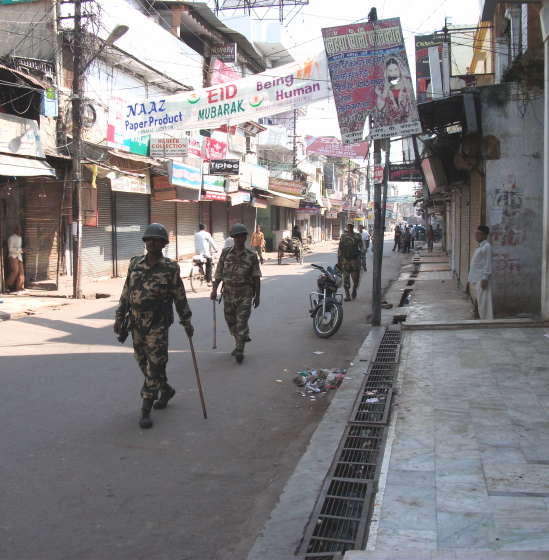
When September 30 dawned on Lucknow, very few people looked relaxed even though the weather was pleasantly cool. Such was the tension that had built up over the previous days and weeks as the city, nay, the entire nation, waited for the legal verdict regarding India’s most vexing religious tussle. The verdict was expected to be delivered at 3.30 p.m. by the Lucknow Bench of the Allahabad High Court. And the case: a civil suit filed by a once-obscure Muslim named Hashim Ansari.
A tailor by profession, Ansari, 90 now, is no longer obscure. A short and slender man, his lined face regularly peeps out from numerous television channels, newspapers and magazines. Not surprising because he had to wait over 60 years to get some kind of an answer to his petition.
The petition involves a less than three-acre piece of land in the temple town of Ayodhya, 135 kilometers from Lucknow, where he resides in a small two-room house. And the piece of land is one which millions of Hindus revere as the birthplace of one of their principal gods-Lord Ram, believed to be one of the ten incarnations or avatars of Lord Vishnu, the protector aspect of the Supreme Triad of Hindu deities (the other two are Brahma the Creator and Shiva the Destroyer).
Here’s where the story turns complex. Hindus also believe that a temple stood on the disputed land and that the Mogul Emperor Babar razed it and put up a mosque in 1528 through his vazir, Mir Baqi. The Muslims (of the Sunni sect) deny it saying that Islamic laws forbid erection of mosques on ruins of any monument belonging to other religions.
The controversy carried on through the British Raj with no solution in sight. Then in 1949, idols of Lord Ram suddenly appeared inside the mosque and the Hindus started praying there. The Muslims protested strongly. Both communities filed civil suits, Hashim Ansari representing the Muslims, and Mahant Paramhans Ramchandra Das, the Hindus. The government, apprehensive of big trouble, locked the gates and declared the entire premises disputed.
In subsequent years, the Nirmohi Akhara, a powerful Vaishnavite organization headed by Sant Bhaskar Das, filed a case, seeking permission to conduct prayer rituals at the site. The Sunni Muslim Waqf Board, the semi-autonomous caretaker of all Sunni shrines and related properties in India, lodged a counter suit in 1961 saying the entire land surrounding the mosque was a Muslim graveyard and should therefore be given to it.
In 1984, the Vishwa Hindu Parishad (VHP) formed a group to regain control of the site to build a temple. First launched in 1964 by Swami Chinmayananda, Master Tara Singh, and SS Apte, the VHP is perceived as an extremely vocal and sometimes militant organization and comprises members drawn from Hindu, Sikh, Buddhist, and Jain faiths. Its professed objective: To consolidate, strengthen and make invincible the global Hindu fraternity by following values based on Sanatan Dharma i.e. Hinduism, and work for the welfare of humanity on the basis of the unique cultural ethos of Bharatvarsha i.e. India.
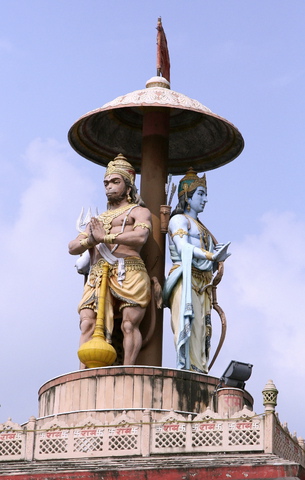
The site at Ayodhya then attracted the attention of politicians. The Bharatya Janata Party, under the leadership of LK Advani, got into the act with a clarion call for Hindutva or the Hindu Way of Life. In 1990, he launched the Ram Rath Yatra or Journey by Chariot in the name of Lord Ram from Somnath in Gujarat (which was symbolic because that was where Mahmud of Ghazni repeatedly invaded and plundered India centuries ago) to Ayodhya in Uttar Pradesh (the epicenter of the golden age of Ram Rajya in ancient India because of Lord Ram’s noble and wise rule). The use of a traditional vehicle, the message of a resurgent India of Hindu culture and ethos, and the promise of erecting a befitting temple at Ayodhya all combined to make the journey a huge success with the public. The religious passion and fervor evoked amongst the people was such that when Advani reached Bihar, he was stopped and arrested by the then Chief Minister, Laloo Prasad Yadav. The central government, led by VP Singh, which was supported by BJP and other parties, fell.
In 1992, workers of the BJP, together with members from Vishwa Hindu Parishad and Rashtriya Swayamsevak Sangh (RSS) marched to Ayodhya and demolished the 464 years old mosque saying that a temple for Lord Ram would once again rise at the same spot. (The RSS was founded in 1925 by Dr. KB Hedgewar in Nagpur to oppose British colonialism and Muslim separatism, the RSS has become a massive Hindu organization with membership of several millions. Amongst its objectives are to provide immediate relief in areas hit by natural calamities, besides assisting in rural health and education programs.)
Ayodhya literally bled. A stunned world watched the inept handling of the situation by both the state and central governments, led by Kalyan Singh of the BJP and PV Narsimha Rao of the Congress respectively. The central government allowed a makeshift temple to come up before appealing to the high court for imposition of status quo at the site.
But it was far from over. A series of reprisals and counter-reprisals took place down the years: riots all over the country which claimed 1500 lives, the 1993 bomb attack by terrorists in Mumbai which killed 257 people, the banning of various radical groups of both communities, and lodging of cases against politicians responsible for bringing the mosque down. India became dangerously polarized.
It’s only in recent years, with India making giant strides in global trade and the youth seemingly serious about education and careers that the situation has eased somewhat. Yet the question now on everybody’s lips was: would the high court verdict create fresh trouble? What if the verdict favored one community over the other?
* * *
When I stepped out of my house on September 30, Lucknow wore a deserted look. Shops and markets were shut. Those trying to open were dissuaded by the patrolling police. Groups of Rapid Action Force, armed to their teeth, prowled the streets. Water canons and bamboo barricades were located at strategic locations. Office-goers sped by in two and four wheelers with uncertainty serving as the prime accelerator. And at the High Court, advocates and journalists tried to sweet-talk the police to gain entrance in the early hours itself. But no go. Only those directly connected with the case (and whose names were with the police) were allowed entry. All others had to wait for the official version of the verdict at around 4 p.m. I went away disappointed.
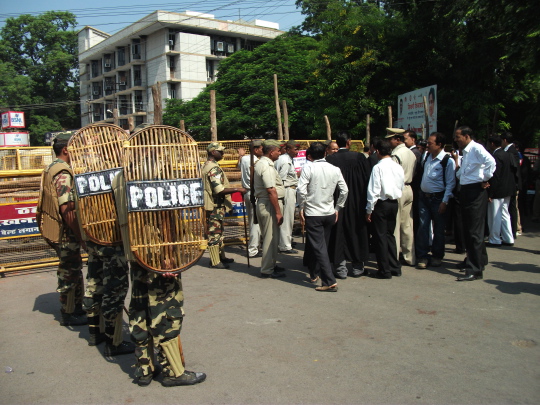
In hindsight, it was a good decision because that evening TV channels showed advocates jostling one another to climb on to the dais. Two lawyers tried to read out the verdict to a 400 strong international media but in vain. Then, in desperation, journalists swarmed the stage to grab copies of the verdict. The dais almost fell apart.
* * *
Without going into technicalities (the judgment runs into 30,000 pages), let me summarize the verdict:
a) The disputed site of 2.77 acres would be divided into three parts between Ram Lulla (literally, Ram as child and represented by a ‘friend’), the Nirmohi Akhara and the Sunni Muslims Waqf Board.
b) The Waqf Board’s plea for the land beneath the middle dome of the original mosque was dismissed.
c) Taking evidence from a 574 page report by the Archaeological Society of India, as also the faith of millions of Hindus, the court ruled that a massive 10th century Hindu temple was indeed present on the site where the mosque was built.
d) The mosque was not built according to Islamic tenets by Emperor Babar.
e) Status quo would be observed by all parties for three months. In other words, this was time granted for appeal to the Supreme Court.

* * *
Call it prescience or instinct, I somehow sensed that there existed some interesting aspects that would be worth investigating. It was therefore with great enthusiasm that I accepted this assignment for Religioscope. My mission:
a) to find out what ordinary folks really thought of the high court verdict,
b) to get an inkling of why reconciliation between the two communities is such a tough proposition, and finally,
c) to get a feel of the sensitive towns of Lucknow, Faizabad, and Ayodhya in the aftermath of the verdict.
* * *
As if to kick start my investigation, Mulayam Singh, leader of the Samajwadi Party and erstwhile Chief Minister of this state of Uttar Pradesh in northern India, and who has been itching to get back into power, said: “Muslims have been cheated.” Most leaders of both communities rubbished the statement. Chief Minister Mayawati declared that such statements would communalize the society. Prime Minister Manmohan Singh appealed for calm and exhorted any aggrieved party to approach the Supreme Court. The Bharatiya Janata Party and its allies uncharacteristically celebrated in a low key and invited Muslims to join in building a grand temple for Ram.
But the question remained: did Mulayam Singh voice what millions of Muslims really felt?
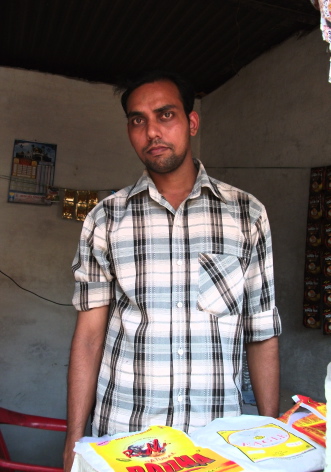
“To an extent, yes,” said Akmal Ameen, 26, a tall slim man with intense eyes but a measured manner of speech. A graduate in arts, he operates a Gopaljee ATM (Any Time Milk) machine from a small shop in Tilaknagar. “Everyone knows that Muslims have got a raw deal. Take for instance Kalyan Singh, the infamous Chief Minister of this state when the mosque was demolished in 1992. He allowed it to happen. Recently Kalyan Singh went around Ayodhya saying that whatever the court decision, the Hindus will build a temple. When people like him harbor such extreme attitudes, what hope do we have? Kalyan Singh is actually challenging the government. He must be investigated and prosecuted for inciting communal passions.”
Akmal felt that the verdict was based on faith, not facts. Also the part of land that the court has awarded to the Sunni Muslims Waqf Board is inappropriate.
“The idols of Hindu gods were installed in 1949. Everyone knows that. They were not there before. The Waqf Board is the sole authority for all mosque related property. They have the documents. They work in consultation with the central government. They decide how a mosque has to be built, the wazur khana for ablutions, the madarasa for students, the main hall for prayers or namaz and so on. This mosque was correct in the way it was built by Babar. Otherwise the Waqf Board wouldn’t have accepted the property. Still, if the court says that the mosque has not been built strictly according to Islamic tenets, it seems to be a weak argument to deny us justice.”
He said that the Waqf Board has no other option but to appeal to the Supreme Court. “In all probability the Supreme Court will base its decision on the High Court verdict. Still, we have some hope that justice will be done. The entire piece of land should be given to us. There should be no division.”
He said that most people in his locality saw the verdict as a compromise. “A compromise so that India can concentrate on conducting the Commonwealth Games in Delhi smoothly in front of an international audience. We Muslims are paying for it.”
Akmal lives in Moulvi Ganj, near the famous shopping district of Aminabad. He claims to represent the views of 700 to 800 Sunni Muslims in his locality, both young and old. He says that the other sect of Mulsims, the Shias, although not directly affected by the verdict, support the Sunnis in their demand for the entire land. He also says that Chief Minister Mayawati is correct in not interfering in the dispute. “She has said that the central government in Delhi would be responsible in implementing the final order, whether to build a temple or mosque, or both. In her heart of hearts she knows the High Court judgment is not correct.”
Which may not be entirely correct, going by newspaper reports. Mayawati has washed her hands off the matter simply because she wants to be seen as someone neutral, someone who needs votes from both communities to stay on in power.
Akmal said that Muslims are in a distressing situation. Their prime concern is to earn a livelihood. Most in the community work long hours for a pittance. They struggle to earn about two hundred rupees daily, as a carpenter or as a tailor or a small time trader. “That’s the story of Muslims in India. But then we also want a just settlement for the Ayodhya dispute. We don’t want to be discriminated. Then again our elders say: since we can’t hope to get justice, let us concentrate on our daily work. Let us avoid conflict. Let us at least earn our daily bread. You can see how distressing our situation is.”
He feels that the findings of the Archaelogical Society of India aren’t conclusive in the Ayodhya case. “Islam does not support destruction of temples to build mosques. What we need from Hindus is compassion and understanding. After all they are the dominant force in India.”
He narrated the story of Mohammed Paigambar, the Prophet, upon whom an old lady hurled rubbish every morning when he walked past her house on his way to a place of worship. Still, Paigambar did not utter a word of protest. One morning, Paigambar was surprised because the expected trash did not come hurtling down. He went up to the old lady’s house and found her in bed, very sick. He gently enquired about her condition, whether she was taking medicines and eating the right foods. The old lady, unable to bear this show of kindness, started to weep in repentance. From then on she converted to Islam. Also, she started to give juice or milk to Paigambar every morning as he walked past her house.
* * *
Next, I met two Hindus from the trading community. Kamla Sankar Awasti, 64, owner of a provision shop near Aishbaug Bridge and JK Goyal, a trader in grains and pulses from Pandeyganj. It would be interesting, I thought, to get their views as they constantly meet a large number of people during the course of their business.
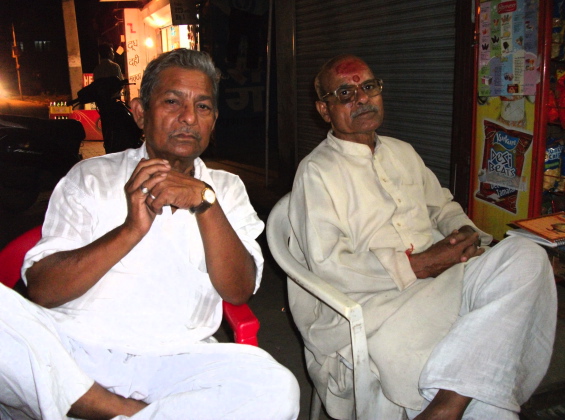
“What Mulayam Singh said was wrong,” declared Goyal. “Every child knows that Lord Ram was born in Ayodhya. Even the Archaeological Society has found that the mosque was built on the ruins of a temple. People also know that Mogul kings razed temples to build their mosques. These are truths. One has to accept them, whether one likes it or not. If you cannot accept a truth, what can anyone do?”
Awasti and Goyal are part of a satsang, a group of about twelve religious people who meet regularly every evening for chanting prayers and songs and also for meditating. The duo claims that all members of the satsang feel the same. Goyal was of the opinion that even if the Muslims appealed to the Supreme Court, truth will prevail.
“Actually they ought to recognize that the verdict is a concession to them. We Hindus are peace loving. History has borne out that fact from ancient times. We don’t want trouble. We are saying, okay take this 1/3rd part of the land and build a mosque. We will build a temple on our part of the land. We don’t want any fights. You are our brothers. All of us pray to the same god, except that tradition and culture has named your god Allah and our god as Ram. That’s all. I have numerous Muslim friends and business associates. We respect each other. And we recognize that this tussle is politically motivated. What Mulayam Singh said should be confined to the dustbin. Politicians exploit delicate situations to create enmity between religions for the sake of power.”
Awasti added: “This tussle has gone on for more than half a century. Let us end it.”
* * *
It was interesting to hear the views of a professional like Dr. Naina Talwar. She is 27, hails from New Delhi and is doing her final year of post graduate studies at CSM Medical University in Lucknow. She said that prima facie the judgment is fair. “Until now, political parties were using the dispute to voice biased opinions. That hopefully should be arrested. This decision is primarily given to maintain peace.”

She believes that the youth of the country have for the first time abstained from reacting only because they are focused on more important matters like education and career. “We youth are more concerned about making India a great economic country. We want to make a good place for ourselves under the sun. You can see how peaceful this college premises is despite the fact that we are in a predominantly Muslim area (Chowk district), despite the fact that the socio-economic profile in this locality is on the lower side. Not a single incident of protest or violence.”
Naina pointed out that both women and men in her profession hold similar views because gender does not matter these days. “Women are no longer confined to their homes in urban India. But yes, being a girl in a city away from my hometown of Delhi was cause for worry for my parents. My husband too, a dentist like me, was rather concerned. But thank god, nothing happened on September 30.”
She also stressed that professionals like her do not discriminate colleagues on the basis of religion. Those days were past when even meeting people from the Muslim community was considered taboo. “The taboo was because of our parents and grandparents, their traditional beliefs and fears. Times have changed. Our generation believes chiefly in merit and character. We are quite happy mingling with people of different communities. For example, the Head of our Department is a Muslim. He invited us home for Id celebrations. We enjoyed ourselves so much! As I said, this was possible because only knowledge, merit, and character matter to us. I guess that is the advantage of higher education–viewing the world in a macro perspective.”
Again, Naina chose to take a macro perspective of one vital aspect of the mosque-temple issue: “The Moguls may have razed temples, but that was the character of those times. Kings put a stamp on their conquests by razing anything that was ‘foreign’. It’s quite stupid to justify fundamentalism of any sort today because of historical happenings. And it would be even more stupid to fritter away time in involving ourselves in such disputes rather than concentrating on building ourselves, our country. Is it a good idea to kill people to make a place for prayer? We as a nation should stay as far as possible from the likes of Mulayam Singh or Kalyan Singh. Let’s stop bringing religion into everything.”
When I asked her if she believed that the current situation could attract trouble-makers from foreign countries like Pakistan etc, she dismissed the idea saying that would only happen if we allowed it to happen.
* * *
Atif is 28, dashing, and eager to express a lot. He works as a guide with the State Tourism Department. As he escorted me in the early hours of the morning through the old parts of Lucknow, which has some magnificent monuments from the Nawab era of the 18th century, he said that politics is the biggest culprit; the Ayodhya dispute could have been solved twenty years ago. “Hindus and Muslims have avoided visiting that place after the mosque was destroyed. Now that the court has decided, I would urge my Muslim brethren to accept the decision.”
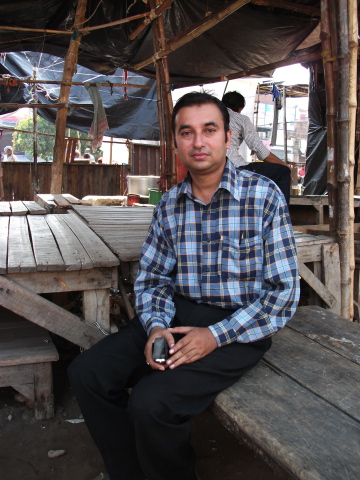
Did he have Hindu friends?
“Oh yes. But we avoid talking about Ayodhya because it might strain our friendship.”
Atif lives in Amberganj on Hardoi Road in Lucknow and is part of a thousand-strong Sunni Muslim community there. “The Shias who are concentrated mainly in the Chowk area have nothing to do with the dispute although they support us.” Atif is a B.A. who has majored in history. He admits that Mogul kings did destroy Hindu temples but he doubts they built mosques on such ruins. “Even if they were not greatly educated, Mogul kings did know it is against Islamic laws to build a mosque on land that belonged to other religions.”
Atif says he is religious; so is his family. Such an upbringing has led him to believe that the Hindu deity, Lord Ram, was indeed born in Ayodhya. “We read about it since childhood. And our parents have heard about it since their childhood. So, in our community, we believe it. We agree to the court decision. But let it not be a precedent to creating more problems for Muslims by spreading the issue to say, Mathura and Varanasi where there are mosques adjoining temples (Krishna temple and an Idgah in Mathura and Kashi Vishwanath temple and the Gyanvapi Mosque in Varanasi).”
Atif has a diploma in pharmacy. He dreams of making a good life for himself in business. “I want to open a pharmacy shop. An investment of close to a million rupees. I am hopeful of getting a bank loan.” He says that youngsters like him in their teens and twenties are more concerned about education and career rather than religious issues.
* * *
My next stop: the twin towns of Faizabad and Ayodhya. Faizabad is a small town with surprisingly good roads (no bumps or potholes). No building is more than a few stories high. I saw plenty of students, boys and girls, jogging in track suits or zooming about on two wheelers, their hair flailing, their faces confident. This was young India. An India where more than 50% of the population is under 25 years of age.
The town’s main attraction was the shopping district of Chowk enclosed within four historic gates. The area teemed with commerce of every variety. Shops twinkled against a background of generator noise (power outages are lengthy). People moved about in their vehicles, alighting here and there to peek at all the attractive wares on display: bangles, saris, jewelry, electronic goods, sweetmeats and savories, fruits and nuts. The police seemed to be a fairly conspicuous presence, especially at road junctions, astride two wheelers or sitting in chairs, watching a dusty noisy world go by. A few wielded rifles and machine guns. But none of them appeared bossy or threatening.
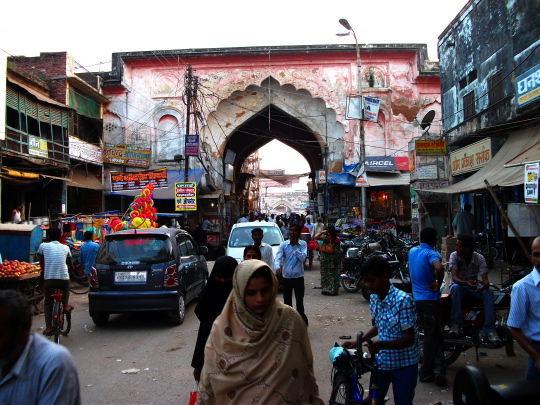
As the sun prepared to set down for the day, I stood on the pavement, entranced by a beautiful white structure that seemed to lift out of a fairy tale. It was the mosque of Nawab Hasan Raza Khan, looking independent of all the human chaos around. A fruit vendor nearby mentioned that I may have to wait for at least an hour because the Imam was getting ready for the 7 o’clock namaz or prayers. The man seemed cheerful. I went up to him.
Fifty year old Mohammed Siddiq has been selling fruits for the last 35 years. “I started this business soon after my father passed away. Question of livelihood, what to do? I couldn’t study.” He said that eighty percent of his community in Faizabad believes that the issue of the mosque or temple should not be prolonged any more. “What is the use? We have to concentrate on our jobs, our trades. We have to live peacefully. This is Hindustan as our country is called in Hindi. A land largely of Hindus. We have to go by what the majority says.”
Nearby, a vendor of bananas, forty-eight year old Mohammed Sharif, butted in to put forth a divergent view. “Actually the court should have divided the land between Muslims and Hindus. Two equal parts for the two main litigants. Sunni MuslimWaqf Board 50%. The Nimhora Akhara 50%. That would have satisfied us. Not three parts or ten parts or twenty parts!”
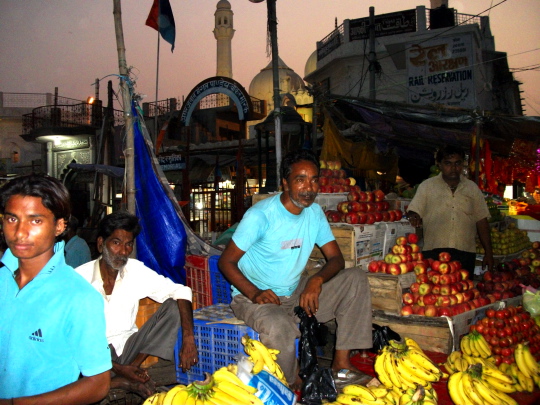
So, he agreed with the Waqf Board’s decision to appeal to the Supreme Court?
“Yes. But I want to mention that Muslims and Hindus have lived amicably in this region. No tension. We eat and live together. Even during the 1992 demolition of the mosque we refrained from violence with our Hindu brothers. It is the people outside, the politicians and power brokers who create tension. To get votes. To make money.”
* * *
The next morning I drove on to the temple town itself, Ayodhya. What I saw now was nowhere approaching the ‘bleeding’ situation of 1992. Spires and domes of temples, big and small, old and new, poked from behind numerous shops that lined either side of the main road. Nearly all of them were filled with Hindu prayer items-pictures of gods and goddesses, colored powder, betel leaves and nuts, flowers, coconuts, sweets, and joss sticks of every aroma imaginable. One local inhabitant proudly informed me that there were about 8000 temples in Ayodhya. It was a figure that worried me for several days because I found it difficult to believe; I ought to have verified it with some reliable authorities, but other matters were on top of my mind. First, to see the disputed site of 2.77 acres.
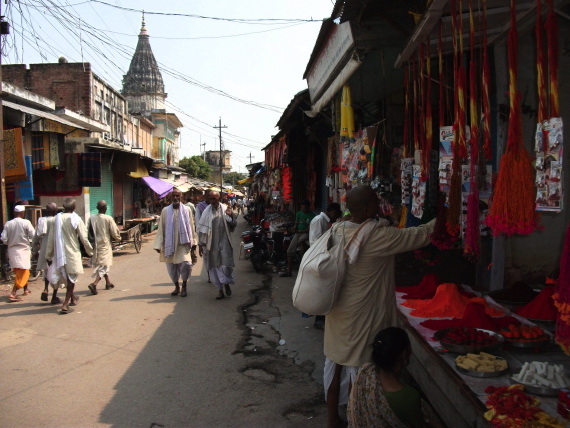
As I walked through the sparse crowd trickling around the Hanuman Gaddi area, the entrance to the temple district, a teen-aged boy rushed up to me, saying he would show me everything, all the temples mentioned in the epic Ramayana: the place where Lord Ram was born, the place where his loyal brother Bharat ruled the kingdom, the palace where Ram’s consort, Sita, used to stay, and temples to Hanuman, the tireless devotee of Ram. As he said all this in an obviously well-rehearsed speech, I cut him short saying, please take me straight to the disputed site. The Ram Janmabhoomi. The birthplace of Ram. The boy tried to calm me down. “Of course, Sir. But first some of the magnificent temples, surely?”
I agreed somewhat reluctantly. The path was almost deserted. The shops lining on one side had only a few pilgrims looking at the goods on display. Atif’s words came to my mind: Hindus and Muslims have avoided coming here after 1992.
Within fifteen minutes I realized I was being conned, for the boy took me to a temple on the wayside. I was the lone pilgrim. The gods were screened off by a curtain. A sleepy priest woke up, drew the curtain across to reveal several idols attired in gaudy silks. “On the left is Lakshmana, brother of Lord Ram,” the priest began dully. It was as if he was reading from a teleprompter located behind me.
“Say Ram ki jai!” prompted the boy next to me.
The words stuck in my throat.
“Would you want to do an annual prayer ritual in your name?” the priest asked.
“Just hundred rupees,” added the boy.
Then I knew they were in this together; the boy was the priest’s net to fish for pilgrims. Surely there were many more boys like him owing allegiance to other priests of other temples. When we came out, I told the boy: no more temples, no more donations, just take me on the road leading to the disputed site.
The boy agreed. We started off. When we came to a turn beyond which some twenty or thirty pilgrims were lined up at a barricade, the boy said, “That’s the place. The police are there. No cameras. No mobiles.”
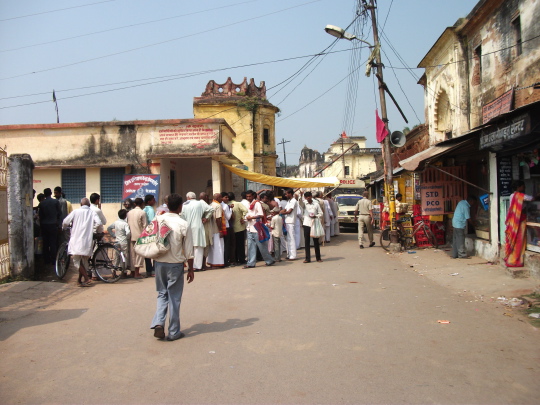
“I am a journalist,” I said.
“No cameras, no mobiles.”
“Let me see,” I said.
“Go ahead,” the boy said and fell back twenty paces. Only later did I realize that he was scared; he didn’t want to be caught by the police for bringing in journalists loaded with cameras and mobiles.
I tried to reason with one of the head constables to allow me into the disputed site (which was some two hundred yards farther off) but he pointed to my camera. “You can keep it with us,” he offered.
I didn’t like the idea of handing over a brand new camera. I looked around. The boy guide had vanished. I trudged back and at the corner a sign on a gate caught my eye. Vijay Vikram Singh-Advocate, High Court.
* * *
On the day of the Ayodhya dispute judgment, 32 year old Vijay was not able to enter the high court in Lucknow where he practices, because his mother was ill. “I watched it all on TV,” he said. Speaking of TV, he said there was a closed circuit tv system outside his house. “To keep a 24 hour surveillance.”
Perhaps, I thought, it must have caught me entering Vijay’s house and was waiting for me to exit peacefully back to wherever I came from.
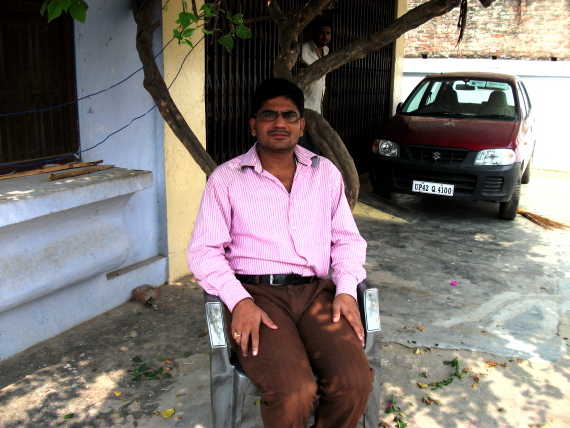
“We are in the yellow zone,” Vijay continued. “Meaning you need to have a pass to move about freely. Near the disputed site it is the red zone. Then beyond my zone is the green and blue zone where there are not many restrictions.”
Vijay said that all this police presence was unnecessary, that it only heightened tension and tempers. “The people of Ayodhya – numbering about 50,000 as per the last government census, of which only 10% are Muslims-want peace. My colleagues at the High Court too feel that this issue should be finalized. Reconciliation is the main thing. It can be done fast. No victor. No loser. If you go to the courts, there are inevitably losers and victors. The media should play a constructive role instead of subtly inflaming communal passions. Politicians and people who have no connection with the title suit should stay away from this matter.”
He said that Hashim Ansari the original litigant was keen on a reconciliation formula but the Sunni Muslim Waqf Board wanted to appeal to the Supreme Court. Ansari had met Mahant Gyan Das of the Akshara Parishad, the apex body of Hindu saints comprising 14 akharas or divisions–the Nirmohi Akhara, headed by Bhaskar Das, is one of them-three or four times but nothing as yet emerged as a practical solution. “I would say build the temple. Only then peace would come to this town.” He said that the Vishwa Hindu Parishad had started collecting money for the temple building some time back but had stopped it.
* * *
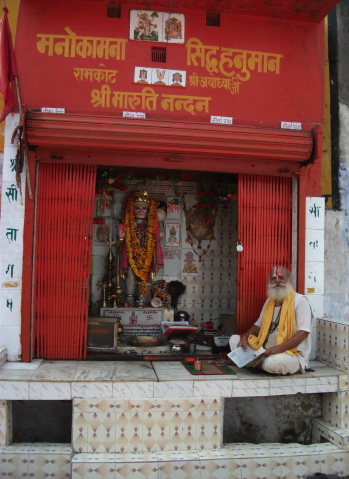
Money is the prime motivation for this conflict, said 70 year old Pandit Ram Sarana Das, who has spent more than half his life in Ayodhya. He is the priest of a small temple dedicated to Hanuman, believed to be Lord Ram’s greatest devotee. “Even Hindus are not content with the court decision which actually favors them. They want all the land. And they are fighting internally as to who will get to control all the key posts once a big temple is established. As far as politicians are concerned, the less said about them the better.”
* * *
Political pressure seems intense on 90 year old Hashim Ansari, the original appellant to this legal wrangle. He is guarded round the clock by a posse of policemen armed with machineguns. Apparently there are threats to his life from the radicals of both communities. When I went to his house, he was chatting with two journalists from regional newspapers. There was also someone who looked distinctly Hindu, going by a slender necklace of sacred beads round his throat. Soon, an unmistakably Muslim gentleman joined us. Hearty in demeanor and impressive in personality, this man, Nabi Bakshi Qadri, claimed to be a social worker from Nawabganj and also attached to the Congress party which rules the central government in Delhi. Over a cup of tea and biscuits, Qadri assured Ansari his full support provided only those directly affected by the dispute are involved in the reconciliation process.
“Of course,” said Ansari. “I won’t have it any other way. Both Hindus and Muslims are with me.”
“Good. I know that. And I also know that they respect you and will remain with you.”
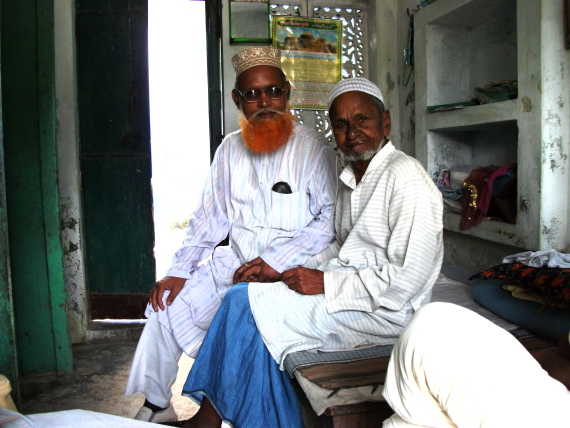
Ansari turned to me. “What is the point of talking of Lord Ram when all that some people want is to hold to their chairs in the state and central government? I am for a peaceful settlement. Let us practice give and take. Let not either party stick too hard to their stated positions.”
Here, Qadri interjected: “Look, when Lord Ram himself went into the forests for 14 years for the sake of society, for upholding a promise to his father, why can’t Hindus climb down from their demands?”
Jugal Kishore Sharan Shastri, who represented an organization called The Voice of Ayodhya, said that all of them had to work together, that one man (apparently hinting at Ansari) couldn’t be expected to bear the full responsibility of negotiating with the other groups.
Ansari seemed lost in thought as he looked at the door, at the police outside sitting on benches and chairs beneath a canvas tent. Now and then one of them came to our door, peeped in, and satisfied that nobody was getting violent, went away.
“No point in looking up at the gods when you keep ignoring what’s on the ground,” continued Shastri. “Did you know that about four months ago, the Supreme Court in Pakistan awarded a disputed piece of land to Sikhs instead of Muslims? When such a thing can happen in a Muslim state, why can’t we in India, supposed to be a secular state, be a little more charitable towards Muslims?”
Just then someone came with tea and biscuits and there was visible relief on everyone’s faces now that they had something else to look at.

Shastri has lived in Ayodhya for 40 years and has worked shoulder to shoulder with such internationally renowned environmental and social activists like Medha Patkar (of the Narmada Dam agitation fame) and Sanjay Pandey (a Magsaysay Award winner). He says he constantly tours the country urging communal harmony. This dispute is actually a great opportunity for all Indians to show the world that they are a secular nation, that Hindus and Muslims pray in the same courtyard.
As I prepared to leave, Shastri fired his parting shot: “Don’t you think the media in India generally puts forth the voice of the upper crust? Rarely is the voice of the people at the grassroots heard.”
* * *
Outside bursts of cool breeze made the heat bearable. Sitting in plastic chairs near a ramshackle cigarette shop on the main road were two policemen: Ahswini Kumar Yadav and Sachidanand Rai, both from Allahabad city.
“Which paper, Sir?” Rai asked, looking at my camera, at my notepad.
I told him.
“You know something, Sir?” he went on. “In the two and half months that we have been here there’s been no problem. Even on September 30, when about a thousand constables were posted here. Now we are just fifty of us. Still, our presence can create tension in this small town. But at the same time we can’t guarantee what can happen, because, you know politicians…”

As I stood there, waiting for a taxi, Yadav, the other constable, said: “Sir, this is a great opportunity actually. To show the world that India is a great country, a peaceful country.” He was echoing what Voice of Ayodhya Shastri had said minutes ago.
“Which way to the Saryu River?” I asked Rai.
He pointed to the right. “Very close. Just five minutes.”
A taxi stopped. I got in. As we drove towards the river, the place where Lord Ram is believed to have bathed every morning before attending to his royal duties, the thought rose in my head. What would he have said about all this going on in his name?
Note: at the time of going to press, reports indicate that the reconciliation process has failed and both parties would be approaching the Supreme Court.
© 2010 Ramesh Avadhani and Religioscope. No part of this article and no picture may be reproduced in any form without permission from Religioscope and the author.